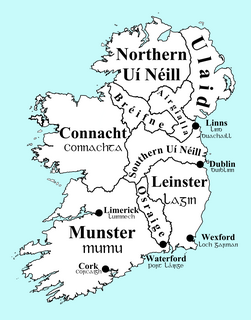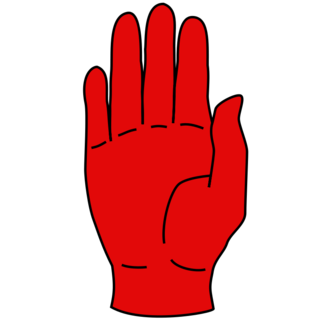Related Research Articles

Ulaid or Ulaidh was a Gaelic over-kingdom in north-eastern Ireland during the Middle Ages made up of a confederation of dynastic groups. Alternative names include Ulidia, which is the Latin form of Ulaid, and in Cóiced, Irish for "the Fifth". The king of Ulaid was called the rí Ulad or rí in Chóicid.

Niall "Noígíallach", or in English, Niall of the Nine Hostages, was a semi-mythical Irish king who was the ancestor of the Uí Néill dynasties that dominated the northern half of Ireland, reigning from the 6th to the 10th centuries. Irish annalistic and chronicle sources place his reign in the late 4th and early 5th centuries, although modern scholars, through critical study of the annals, date him about half a century later. He is presumed by some to have been a real person, or at the very least semi-historical but most of the information about him that has come down to us is regarded as legendary.
Áed mac Néill, called Áed Findliath to distinguish him from his paternal grandfather Áed Oirdnide, was king of Ailech and High King of Ireland. He was also called Áed Olach according to Baile in Scáil, section 51. A member of the northern Uí Néill kindred of the Cenél nEógain, Áed was the son of Niall Caille.

Domhnall Ua Lochlainn, also known as Domhnall Mac Lochlainn, was king of the Cenél Eogain, over-king of Ailech, and alleged High King of Ireland.

The history of Ireland 800–1169 covers the period in the history of Ireland from the first Viking raids to the Norman invasion. The first two centuries of this period are characterised by Viking raids and the subsequent Norse settlements along the coast. Viking ports were established at Dublin, Wexford, Waterford, Cork and Limerick, which became the first large towns in Ireland.
Domnall mac Áedo, also known as Domnall II, Was an Irish king and son of Áed mac Ainmuirech and his consort Land, the daughter of Áed Guaire mac Amalgada of Airgíalla. Domnall was High King of Ireland from 628 until his death. He belonged to the Cenél Conaill kindred of the Northern Uí Néill.
Congal Cáech was a king of the Cruthin of Dál nAraidi in the medieval Irish province of Ulaid, from around 626 to 637. He was king of Ulaid from 627–637 and, according to some sources, High King of Ireland.
Niall mac Áeda, called Niall Caille to distinguish him from his grandson Niall mac Áeda, was High King of Ireland.
Ruaidrí ua Canannáin was king of the Cenél Conaill, and according to some sources, High King of Ireland.

The Earldom of Ulster was an Anglo-Norman lordship in northern medieval Ireland, established by John de Courcy from the conquest of the province of Ulaid in eastern Ulster. It was the most important Anglo-Norman lordship in the north of Ireland. At its greatest extent it extended as far west as the Inishowen peninsula in modern-day County Donegal, which was at one time the power-base of the Northern Uí Néill.
Flaithbertach Ua Néill was king of Ailech, a kingdom of north-west Ireland. He abdicated in 1030 and undertook a pilgrimage to Rome, for which reason he was known as Flaithbertach an Trostáin. Following the death of his son Áed in 1033, Flaithbertach left his retirement and resumed the leadership of the Northern Uí Néill.
Fiachnae mac Áedo Róin was a Dál Fiatach ruler of the over-kingdom of Ulaid in Ireland. He reigned from 750 to 789. He was the son of Áed Róin and brother of Bressal mac Áedo Róin, previous kings. This family had their base in modern-day County Down, Northern Ireland.
Eochaid mac Fiachnai was a Dal Fiatach king of Ulaid, which is now Ulster, Ireland. He was the son of Fiachnae mac Áedo Róin, a previous king. He ruled from 790 to 810.
Muiredach mac Eochada was a Dal Fiatach king of Ulaid, medieval Ireland. He was the son of Eochaid mac Fiachnai, a previous king. He ruled from 825-839.
Ainbíth mac Áedo was a Dál Fiatach king of Ulaid, which is now Ulster, Ireland. He was the grandson of Eochaid mac Fiachnai, a previous king of Ulaid. He ruled from 873–882.
Aitíth mac Laigni was a King of Ulaid, which is now Ulster, Ireland. He belonged to a branch of the Dal nAraide known as the Uí Echach Cobo in the west part of county Down. He ruled as King of Ulaid from 896-98.
Events from the 8th century in Ireland.
Áed in Macáem Tóinlesc or Aodh an Macaoimh Tóinleasg was a 12th-century ruler of Tulach Óc and Tír Eogain. He was the first of his family to play a significant role in the high politics of northern Ireland, following the death of the Muirchertach Mac Lochlainn king of Tír Eogain and high king of Ireland.

The Northern Uí Néill is the name given to several dynasties in north-western medieval Ireland that claimed descent from a common ancestor, Niall of the Nine Hostages. Other dynasties in central and eastern Ireland who also claimed descent from Niall were termed the Southern Uí Néill. The dynasties of the Northern Uí Néill were the Cenél Conaill and Cenél nEógain, named after supposed sons of Niall: Conall and Eógain.
References
- 1 2 3 4 5 Benjamin T. Hudson, ‘Niall mac Eochada (d. 1063)’, Oxford Dictionary of National Biography, Oxford University Press, 2004 accessed 18 April 2008
- ↑ Heald, Henrietta (1992). Chronicle of Britain . Jacques Legrand. p. 172. ISBN 0-19-211695-9.
- ↑ Dáibhí Ó Cróinín, Early Medieval Ireland: 400–1200, Longman, London, 1995, p. 52. ISBN 0-582-01565-0
- ↑ Francis John Byrne, Irish Kings and High Kings, Batsford, London, 1973, p. 286, table 6. ISBN 0-7134-5882-8